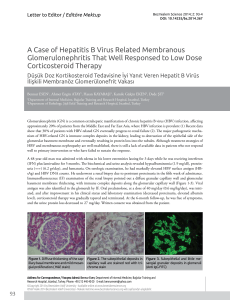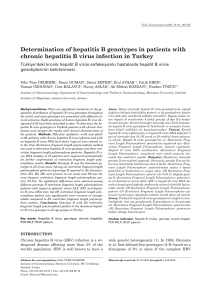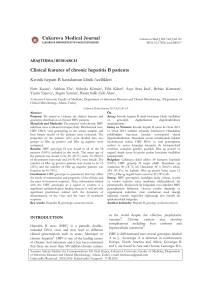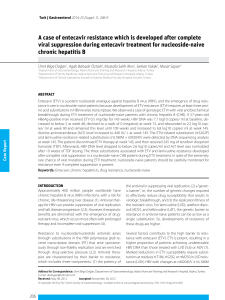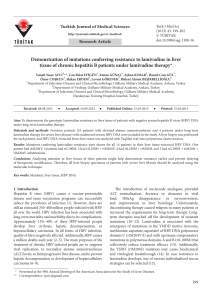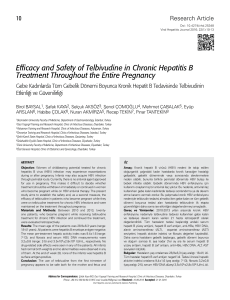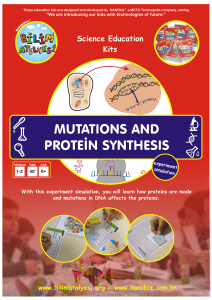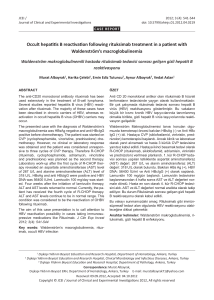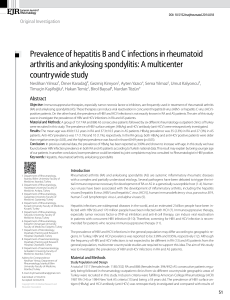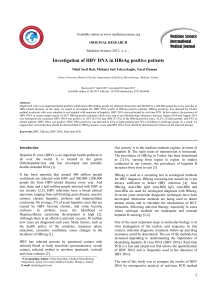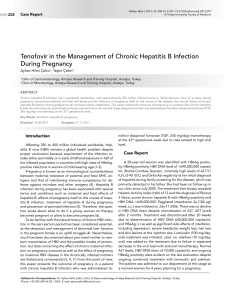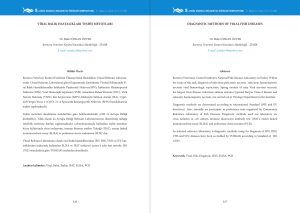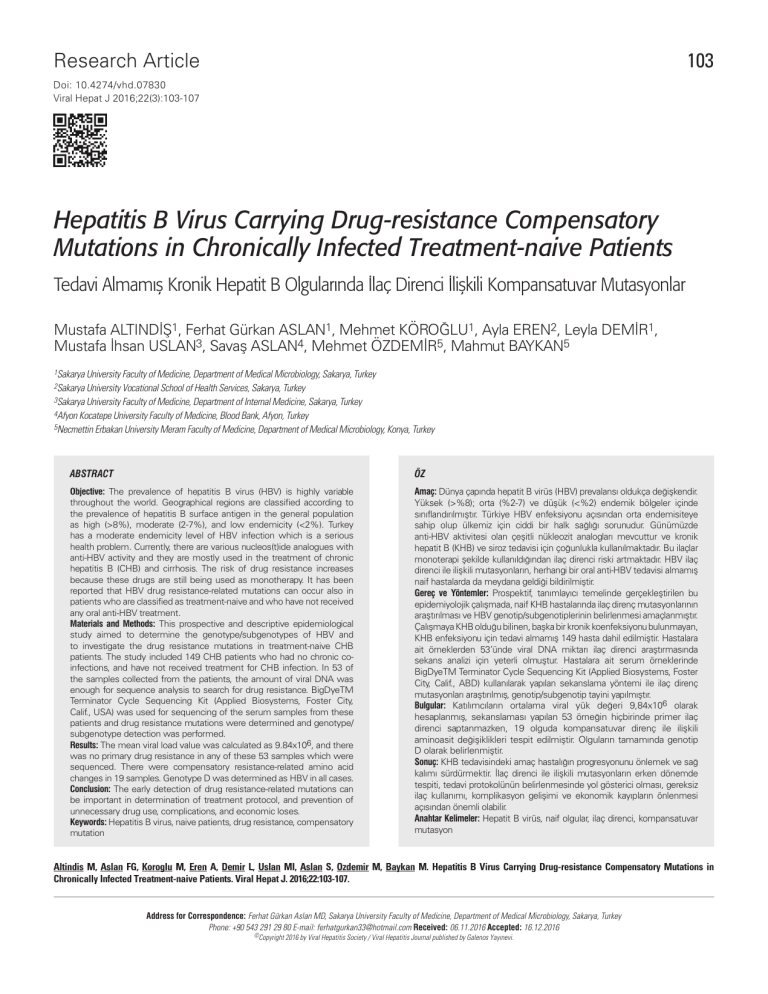
103
Research Article
Doi: 10.4274/vhd.07830
Viral Hepat J 2016;22(3):103-107
Hepatitis B Virus Carrying Drug-resistance Compensatory
Mutations in Chronically Infected Treatment-naive Patients
Tedavi Almamış Kronik Hepatit B Olgularında İlaç Direnci İlişkili Kompansatuvar Mutasyonlar
Mustafa ALTINDİŞ1, Ferhat Gürkan ASLAN1, Mehmet KÖROĞLU1, Ayla EREN2, Leyla DEMİR1,
Mustafa İhsan USLAN3, Savaş ASLAN4, Mehmet ÖZDEMİR5, Mahmut BAYKAN5
1Sakarya University Faculty of Medicine, Department of Medical Microbiology, Sakarya, Turkey
2Sakarya University Vocational School of Health Services, Sakarya, Turkey
3Sakarya University Faculty of Medicine, Department of Internal Medicine, Sakarya, Turkey
4Afyon Kocatepe University Faculty of Medicine, Blood Bank, Afyon, Turkey
5Necmettin Erbakan University Meram Faculty of Medicine, Department of Medical Microbiology, Konya, Turkey
ABSTRACT
ÖZ
Objective: The prevalence of hepatitis B virus (HBV) is highly variable
throughout the world. Geographical regions are classified according to
the prevalence of hepatitis B surface antigen in the general population
as high (>8%), moderate (2-7%), and low endemicity (<2%). Turkey
has a moderate endemicity level of HBV infection which is a serious
health problem. Currently, there are various nucleos(t)ide analogues with
anti-HBV activity and they are mostly used in the treatment of chronic
hepatitis B (CHB) and cirrhosis. The risk of drug resistance increases
because these drugs are still being used as monotherapy. It has been
reported that HBV drug resistance-related mutations can occur also in
patients who are classified as treatment-naive and who have not received
any oral anti-HBV treatment.
Materials and Methods: This prospective and descriptive epidemiological
study aimed to determine the genotype/subgenotypes of HBV and
to investigate the drug resistance mutations in treatment-naive CHB
patients. The study included 149 CHB patients who had no chronic coinfections, and have not received treatment for CHB infection. In 53 of
the samples collected from the patients, the amount of viral DNA was
enough for sequence analysis to search for drug resistance. BigDyeTM
Terminator Cycle Sequencing Kit (Applied Biosystems, Foster City,
Calif., USA) was used for sequencing of the serum samples from these
patients and drug resistance mutations were determined and genotype/
subgenotype detection was performed.
Results: The mean viral load value was calculated as 9.84x106, and there
was no primary drug resistance in any of these 53 samples which were
sequenced. There were compensatory resistance-related amino acid
changes in 19 samples. Genotype D was determined as HBV in all cases.
Conclusion: The early detection of drug resistance-related mutations can
be important in determination of treatment protocol, and prevention of
unnecessary drug use, complications, and economic loses.
Keywords: Hepatitis B virus, naive patients, drug resistance, compensatory
mutation
Amaç: Dünya çapında hepatit B virüs (HBV) prevalansı oldukça değişkendir.
Yüksek (>%8); orta (%2-7) ve düşük (<%2) endemik bölgeler içinde
sınıflandırılmıştır. Türkiye HBV enfeksiyonu açısından orta endemisiteye
sahip olup ülkemiz için ciddi bir halk sağlığı sorunudur. Günümüzde
anti-HBV aktivitesi olan çeşitli nükleozit analogları mevcuttur ve kronik
hepatit B (KHB) ve siroz tedavisi için çoğunlukla kullanılmaktadır. Bu ilaçlar
monoterapi şekilde kullanıldığından ilaç direnci riski artmaktadır. HBV ilaç
direnci ile ilişkili mutasyonların, herhangi bir oral anti-HBV tedavisi almamış
naif hastalarda da meydana geldiği bildirilmiştir.
Gereç ve Yöntemler: Prospektif, tanımlayıcı temelinde gerçekleştirilen bu
epidemiyolojik çalışmada, naif KHB hastalarında ilaç direnç mutasyonlarının
araştırılması ve HBV genotip/subgenotiplerinin belirlenmesi amaçlanmıştır.
Çalışmaya KHB olduğu bilinen, başka bir kronik koenfeksiyonu bulunmayan,
KHB enfeksiyonu için tedavi almamış 149 hasta dahil edilmiştir. Hastalara
ait örneklerden 53’ünde viral DNA miktarı ilaç direnci araştırmasında
sekans analizi için yeterli olmuştur. Hastalara ait serum örneklerinde
BigDyeTM Terminator Cycle Sequencing Kit (Applied Biosystems, Foster
City, Calif., ABD) kullanılarak yapılan sekanslama yöntemi ile ilaç direnç
mutasyonları araştırılmış, genotip/subgenotip tayini yapılmıştır.
Bulgular: Katılımcıların ortalama viral yük değeri 9,84x106 olarak
hesaplanmış, sekanslaması yapılan 53 örneğin hiçbirinde primer ilaç
direnci saptanmazken, 19 olguda kompansatuvar direnç ile ilişkili
aminoasit değişiklikleri tespit edilmiştir. Olguların tamamında genotip
D olarak belirlenmiştir.
Sonuç: KHB tedavisindeki amaç hastalığın progresyonunu önlemek ve sağ
kalımı sürdürmektir. İlaç direnci ile ilişkili mutasyonların erken dönemde
tespiti, tedavi protokolünün belirlenmesinde yol gösterici olması, gereksiz
ilaç kullanımı, komplikasyon gelişimi ve ekonomik kayıpların önlenmesi
açısından önemli olabilir.
Anahtar Kelimeler: Hepatit B virüs, naif olgular, ilaç direnci, kompansatuvar
mutasyon
Altindis M, Aslan FG, Koroglu M, Eren A, Demir L, Uslan MI, Aslan S, Ozdemir M, Baykan M. Hepatitis B Virus Carrying Drug-resistance Compensatory Mutations in
Chronically Infected Treatment-naive Patients. Viral Hepat J. 2016;22:103-107.
Ad­dress for Cor­res­pon­den­ce: Ferhat Gürkan Aslan MD, Sakarya University Faculty of Medicine, Department of Medical Microbiology, Sakarya, Turkey
Phone: +90 543 291 29 80 E-mail: [email protected] Re­cei­ved: 06.11.2016 Ac­cep­ted: 16.12.2016
©Copyright 2016 by Viral Hepatitis Society / Viral Hepatitis Journal published by Galenos Yayınevi.
104
Altındiş et al.
Hepatitis B Virus Drug-resistance in Treatment-naive Patients
Introduction
Hepatitis B virus (HBV) is a viral factor leading to acute and
chronic infections by affecting the liver (1). Even though an effective
hepatitis vaccine has been commonly used, approximately 2
million individuals (almost one third of the world’s population)
encounter the hepatitis virus and it is known that HBV is a growing
global public health problem (2). Probably 240 million people have
chronic HBV infection and more than 686.000 individuals die every
year due to hepatitis B infection-related diseases such as cirrhosis
and liver cancer (1). It has been specified in studies conducted
in our country that the prevalence of hepatitis B surface antigen
varies between 0.8% and 14.3% and it has been reported that our
country has a moderate endemicity level among other regions of
the world (3).
HBV can lead to different clinical outcomes such as
asymptomatic infections, fulminant hepatitis, inactive carrier state,
and even life-threatening diseases such as liver cirrhosis and liver
cancer. Therefore, early detection and treatment of HBV is crucial.
Non-specific factors, such as age, and specific genetic factors in
the host as well as genetic features of the virus can affect the
prognosis of the HBV infections (4). Genetic variance can occur
due to the genotypic differences in carriers or mutations in the
infected host (5,6). Although it has not yet been clarified, findings
support that genotypic differences have effects on the HBV
pathogenicity and the clinical course of the infection. Therefore,
determination of the genotype in the beginning of the disease can
contribute to clinical approaches in a more conscious way (4). It
has been determined that there are 10 different HBV genotypes
(from A to J) in addition to the recently defined genotypes (5,6).
However, there have been a limited number of studies on HBV
genotype distribution in Turkey. In the work done in the obtained
data, genotype D and subgenotype D1 have been found to be a
widely prevalent genotype in Turkey (7,8,9).
Developments in viral techniques used in the diagnosis of
chronic HBV infections ensure that individual treatments can be
more accurately decided. Recently, hepatitis treatment is better
managed by the application of molecular techniques, which
can quantitatively detect HBV DNA, genotype detection, and
determination of the antiviral resistance. It is very important that
the right patient is treated conveniently and the right drug is
used for the sake of the future of both the patient and the drug.
Therefore, the treatment goals and treatments should be accurately
determined (10,11).
Recently, there have been various approved chronic hepatitis
B (CHB) treatments which prominently decrease the mortality
and morbidity rates. They include two interferons (IFNs)
(conventional and pegylated alfa-2a) analogues and five nucleoside/
nucleotide analogues (NAs): lamivudine (LAM), telbivudine (TBV),
entecavir, adefovir (ADV), and tenofovir. NA inhibits the activity
of HBV polymerase and suppresses its replication by binding it
competitively. However, the drug resistance is a common problem
in long-term treatments (12). Furthermore, recent studies showed
that there is an antiviral resistance even in HBV isolated from nontreated patients (13).
In this study, the pol and s gene kinetics İN treatment-naive
HBV patients were evaluated by using the sequencing technique
and drug resistance-related mutations were examined. The aim of
the study was to determine the HBV genotype and subgenotypes
and thus contribute to the epidemiological data.
Materials and Methods
In this prospective and descriptive epidemiological study, we
included a total of 149 patients who had no any infection except
CHB and who were treated for CHB between January 2012
and May 2013. Blood samples obtained from the patients were
used for routine laboratory tests and then remaining blood serum
samples were stored at -80 ⁰C till they were used. The amounts
of viral DNA in 53 samples were sufficient for drug resistance
sequence analysis assay. The demographic and clinical data of
participants were obtained from the hospital records. The ethical
approval of this study (15/10/2015-12797) was obtained from
Sakarya University.
HBV DNA levels were measured by the real-time polymerase
chain reaction (RT-PCR) technique with the help of a Cobas
TaqMan 48 kit (Roche Diagnostics, USA). The degenerate primers
were used to amplify the 16S gene, from HBV samples and from
isolates. The PCR products were purified with a QIAquick PCR
Purification Kit (Qiagen) and used for direct sequencing using a
BigDyeTM Terminator Cycle Sequencing Kit (Applied Biosystems,
Foster City, Calif., USA), and an ABI-3100 at the Center for
Comparative Genomics at the University of Iowa (Iowa City, Iowa,
USA). The sequences for phylogenetic analysis were retrieved
from DDBJ/EMBL/GeneBank. Alignments were carried using
CLUSTALW [http://clustalw.ddbj.nig.ac.jp/top-e.html] and neighborjoining tree was formed. Statistical differences were analyzed by
DNA polymorphism levels within locations and mutations were
summarized in haplotype diversity (h) and nucleotide diversity (π)
with standard deviation. Population expansions were assessed by
neutrality tests implemented in DnaSP v.5.10.01, for the Tajima’s
D and the Fu and Li’s F.
Results
Gene sequences of PCR products in 53 patients (41 male
and 12 female) were obtained by using PCR and sequencing
techniques. The amount of DNA samples in the rest of patients
was not sufficient for sequence analysis. The average age of the
patients was 49.3 years (range: 24-74). The average viral load was
9.84x106 IU/mL (range: 1.346x101 IU/mL-4.383x108 IU/mL. Some
demographical characteristics and laboratory findings of patients are
shown in Table 1. All the 53 patients had genotype D. Subgenotype
distribution was as follows: 46 patients had genotype D1, 4 patients
had genotype D2, and 3 patients had genotype D3. There was no
primary drug resistance in any of the patients (Table 1). There were
amino acid alterations in 19 patients and these alterations were
associated with compensatory resistance which had roles in viral
replication repair and increased viral loads (Table 2). It was detected
that there were compensatory changes associated with only TBV,
LAM and ADV, and only ADV in 4, 13, and 2 patients, respectively.
Discussion
The final goal of CHB treatment is to prevent the progression
of the disease and to maintain survival. It is possible to achieve
these goals by suppressing HBV replication and maintaining this
Altındiş et al.
Hepatitis B Virus Drug-resistance in Treatment-naive Patients
suppression (14). Recently, seven antiviral agents have been
approved in order to be used in the CHB infection treatment. Two
of them were IFN-α (IFN/pegylated IFN) analogues and five of them
were NAs. NAs suppress HBV replication by affecting the reverse
transcriptase enzyme. The most important issue during long-term
CHB treatment with NAs is the mutagenesis which is responsible
for the antiviral agent resistance. Amino acid alterations in the HBV
reverse transcriptase cause NA resistance which is an important
problem in CHB treatment (6,14). Even though it is specified that
there is no need to examine drug resistance in patients who have
not been previously treated (10,14,15), there can be spontaneous
drug resistance mutations in treatment-naive patients (6). NA
resistance mutations can occur in non-treated patients because
of the viral and patient factors. The reasons for the variance of
resistance in non-treated patients are: 1) these mutations can
naturally occur during the replication (10-5-10-4 substitution/base/
cycle), 2) the patient can be infected by a mutant virus from
another patient who was previously treated, and 3) the patient can
be directly and unconsciously exposed to equivalent components
with anti-HBV activity (12,16). Thus, resistance mutations can be
observed in non-treated patients. These mutations can be primary
drug resistance mutations (drug unresponsiveness) or they can
increase the replication capacities of reduced resistant HBV
variances (11).
In recent studies conducted with non-treated patients in different
countries, it was shown that the frequencies of HBV strains which
had clinically important drug resistance mutation (NA resistance)
Table 1. Demographical characteristics and laboratory information of 53
patients whose DNA was sequenced
Clinical factors
Value
Male/Female
41/12
Average age (year)
49.3 years
HBeAg positive (n)
26
Average ALT (U/mL)
16.7
Average AST (U/mL)
39.8
Average HBV DNA (IU/mL)
9.84x106
HBV genotype (subgenotype)
46 (D1)
4 (D2)
3 (D3)
HBeAg: Hepatitis B envelope antigen, ALT: Alanine aminotransferase, AST:
Aspartate aminotransferase, HBV: Hepatitis B virus
Table 2. Number of compensatory mutation cases in treatment-naive
hepatitis B virus patients
Reverse transcriptase mutations
(compensatory)
Antiviral agent
Case number
Q149K
LAM and ADV
4
Q215S
LAM and ADV
4
Q215H
LAM and ADV
4
L91I
TBV
4
Q249K
LAM and ADV
1
N238D
ADV
1
V214A
LAM and ADV
1
LAM: Lamivudine, ADV: Adefovir, TBV: Telbivudine
105
were between 0.5% and 1% (17,18,19,20,21,22,23,24,25). In our
country, Akarsu et al. (26) evaluated 71 inactive HBV carriers who
have not received any treatment and they detected YMDD variants
(18.3%) in 13 cases. Yıldız et al. (27) detected a primary resistance
against LAM in 8 of 202 LAM-naive CHB patients (4%). Sayan et al.
(28) evaluated 88 treatment-naive CHB patients and they showed
that there were amino acid alterations in HBV polymerase genes in
17 of these patients (19%). Ergünay et al. (29) evaluated 30 CHB
patients who were not previously treated and they determined
HBV NA resistance-related mutations in 3 of them (10%).
In our study, there was no primary drug resistance in any of
the 53 patients. In order to determine the nucleotide alterations
in targeted region of the viral genome, DNA sequence analysis
method was applied by using PCR products. This technique has
an advantage of showing all mutations in the amplified region and
it is accepted as the gold standard for the detection of nucleotide
alterations. However, mutant genomes should constitute at least
20% of the whole viral population in order to detect all of the
mutations in the genome directly by using sequence analysis. In our
study, it is possible that we did not detect primary drug resistance
amino acid alterations because of their low levels. Recent and
new generation sequencing systems can be used to analyze the
whole viral genomes and thus all viral genome pool of infected
people can be examined. However, these approaches cannot be
easily used in all institutions because they require equipments and
experienced staff (29,30). Furthermore, emergence of resistance
variants against approved NAs is the main reason for treatment
failure in CHB infections. Therefore, the treatment can be regulated
timely with the help of the early detection of these mutations and
thus aggravation of the disease can be prevented. Meanwhile, early
detection of these mutations can also contribute to detection of
compensatory mutations which can repair the viral replication and
increase the resistance risk against other drugs (16).
Population sequencing method can be used to detect the
known NA resistance mutations as well as compensatory
mutations. It has been reported that rtQ215H/Q/P/S compensatory
mutations are frequently observed in CHB patients who receive
both NA-naive and LAM and/or ADV treatments (11,12). In our
study, there were compensatory mutations in 19 patients and 4 of
them had rtQ149K compensatory mutation which was associated
with LAM and ADV treatment. Other compensatory mutations
were Q215S mutation associated with LAM and ADV (4 patients),
Q215H mutation associated with LAM and ADV (4 patients), rtL91I
mutation associated only with TBV (4 patients), Q249K mutation
associated with LAM and ADV (1 patients), N238D mutation
associated with only ADV (1 patients), and V214A mutation which
was associated with LAM and ADV (1 patient) (Table 2).
Compensatory mutations which can repair the viral replication
and increase the viral load and particularly the mutations related to
drug resistance in NA target region of the HBV polymerase gene
can be associated with treatment failure. Compensatory mutations
can lead to unnecessary or incorrect medication changes in CHB
patients. Mutation detection in HBV patients can have important
effects on the development of different treatment strategies (31).
It has been specified that there are at least 10 HBV genotypes
(A-J) in case of differences more than 8% in the HBV genome.
Some genotypes are divided into subgenotypes in case there is
106
Altındiş et al.
Hepatitis B Virus Drug-resistance in Treatment-naive Patients
a 4-8% difference between nucleotide sequences. Recent data
has shown that genotypes are determining factors affecting
the severity of the liver disease and the response against the
antiviral drug (7). Furthermore, HBV genotype D is the most
commonly determined genotype in our country and the most
commonly observed subgenotype is the genotype D1. Even
though Kaklikkaya et al. (7) have reported that the most commonly
observed genotype was genotype D2, other studies claimed that
the genotype D1 was the most frequently detected one in our
country. In our study, all patients were classified as HBV genotype
D and the most frequently detected genotype was genotype D1.
Genotype D2 and genotype D3 were the other genotypes that can
be observed in Turkey.
NA combinations are important in treatment-resistant patients
and initial treatment selection and subsequent treatment decisions
should depend on the resistance rates (6). Consequently, early
detection of antiviral drug resistance-related mutations can be
important in determination of the most convenient treatment
protocol. Thus, toxicity and economic losses due to unnecessary
drug use can be prevented and severe complications can be
reduced (32,33). Although we did not detect such mutations in our
study, there are other studies in which drug resistance mutations are
detected in treatment-naive CHB patients. Furthermore, it will be
clinically useful to determine the resistance profile since treatmentnaive CHB patients develop primary drug resistance against LAM
and ADV (29). Further studies investigating mutations in the viral
polymerase region and determining the clinical importance of
these mutations in treatment-naive patients are warranted.
Ethics
Ethics Committee Approval: The ethical approval of this study
(15/10/2015-12797) was obtained from Sakarya University.
Peer-review: External and Internal peer-reviewed.
Authorship Contributions
Surgical and Medical Practices: Mustafa Altındiş, Concept:
Mustafa Altındiş, Design: Mustafa Altındiş, Ferhat Gürkan Aslan,
Mehmet Köroğlu, Data Collection or Processing: Mustafa Altındiş,
Ferhat Gürkan Aslan, Mehmet Köroğlu, Leyla Demir, Mustafa İhsan
Uslan, Savaş Aslan, Mehmet Özdemir, Analysis or Interpretation:
Mustafa Altındiş, Ferhat Gürkan Aslan, Mehmet Köroğlu, Ayla
Eren, Mahmut Baykan, Literature Search: Mustafa Altındiş, Ferhat
Gürkan Aslan, Ayla Eren, Writing: Mustafa Altındiş, Ferhat Gürkan
Aslan, Ayla Eren.
Conflict of Interest: No conflict of interest was declared by the
authors.
Financial Disclosure: The authors declared that this study
received no financial support.
References
1. http://www.who.int/mediacentre/factsheets/fs204/en/ (last acces:
10.09.2016)
2.
Otlu B. Hepatit B Virüsünde Moleküler Testler. İçinde: Altındiş M, Tabak
F. Hepatit Mikrobiyolojisi. 1. Baskı, İstanbul: İstanbul Medikal Sağlık ve
Yayıncılık; 2015; p. 101-114.
hepatit B olgularında direnç paterninin araştırılması. Mikrobiyol Bul.
2010;44:237-243.
5.
İnan N. Hepatit B Virus Biyolojisi. Ed: Altındiş M, Tabak F. Hepatit
Mikrobiyolojisi. 1. Baskı, İstanbul: İstanbul Medikal Sağlık ve Yayıncılık;
2015; p. 52-66.
6.
Zhang Q, Liao Y, Chen J, Cai B, Su Z, Ying B, Lu X, Tao C, Wang L.
Epidemiology study of HBV genotypes and antiviral drug resistance in
multi-ethnic regions from Western China. Sci Rep. 2015;5:17413.
7.
Kaklikkaya N, Sancaktar M, Guner R, Buruk CK, Koksal I, Tosun I, Aydin
F. Hepatitis B virus genotypes and subgenotypes in the Eastern Black
Sea region of Turkey. Saudi Med J. 2012;33:622-626.
8.
Cox LE, Arslan O, Allain JP. Characterization of hepatitis B virus in
Turkish blood donors, and the prevalence of the SP1 splice variant. J
Med Virol. 2011;83:1321-1325.
9.
Amini-Bavil-Olyaee S, Tacke F, Alavian SM. HBV subgenotypes D1,
D2, D-del! Are “old”genotyping methods interpreted correctly? Hepat
Mon. 2013;13:13048.
10. Kim JH, Park YK, Park ES, Kim KH. Molecular diagnosis and
treatment of drug-resistant hepatitis B virus. World J Gastroenterol.
2014;20:5708-5720.
11. Akhan S, Aynıoglu A, Cağatay A, Gönen İ, Günal Ö, Kaynar T, Kuruüzüm
Z, Sayan M, Tunca B, Tülek N, Üçkardes H, Yavuz A, Yıldız O, Yılmaz N,
Yüksel E. Kronik hepatit B virusu infeksiyonunun yönetimi: Türk Klinik
Mikrobiyoloji ve İnfeksiyon Hastalıkları Derneği Viral Hepatit Çalışma
Grubu Uzlaşı Raporu. Klimik Dergisi. 2014;27:2-18.
12. Gomes-Gouvêa MS, Ferreira AC, Teixeira R, Andrade JR, Ferreira AS,
Barros LM, Rezende RE, Nastri AC, Leite AG, Piccoli LZ, Galvan J,
Conde SR, Soares MC, Kliemann DA, Bertolini DA, Kunyoshi AS, Lyra
AC, Oikawa MK, de Araújo LV, Carrilho FJ, Mendes-Corrêa MC, Pinho
JR. HBV carrying drug-resistance mutations in chronically infected
treatment-naive patients. Antivir Ther. 2015;20:387-395.
13. Panigrahi R, Biswas A, De BK, Chakrabarti S, Chakravarty R.
Characterization of antiviral resistance mutations among the Eastern
Indian Hepatitis B virus infected population. Virol J. 2013;10:56.
14. Zoulim F. Hepatitis B virus resistance to antiviral drugs: where are we
going? Liver Int. 2011;31:111-116.
15. Li X, Liu Y, Zhao P, Wang Y, Chen L, Xin S, Zhang XX, Xu D. Investigation
into drug-resistant mutations of HBV from 845 nucloside/nucleotide
analogue-naive Chinese patients with chronic HBV infection. Antiviral
Therapy. 2015;20:141-147.
16. Mirandola S, Campagnolo D, Bortoletto G, Franceschini L, Marcolongo
M, Alberti A. Large-scale survey of naturally occurring HBV polymerase
mutations associated with anti-HBV drug resistance in untreated
patients with chronic hepatitis B. J Viral Hepat. 2011;18:212-216.
17. Alvarez Estevez M, Chueca-Porcuna N, Guillot-Suay V, Pena-Monje A,
Garcia- Garcia F, Garcia-Garcia F. Low prevalence of hepatitis B virus
primary drug resistance in Southern Spain. Enferm Infec Microbiol Clin.
2013;31:520-522.
18. Ismail AM, Samuel P, Eapen CE, Kannangai R, Abraham P. Antiviral
resistance mutations and genotype-associated amino acid substitutions
in treatment-naive hepatitis B virus-infected individuals from the Indian
subcontinent. Intervirology. 2012;55:36-44.
19. Jardi R, Rodriguez-Frias F, Schaper M, Ruiz G, Elefsiniotis I, Esteban
R, Buti M. Hepatitis B virus polymerase variants associated with
entecavir drug resistance in treatment-naive patients. J Viral Hepat.
2007;14:835-840.
20.
3.
Çetinkol Y, Yıldırım AA, Çalgın MK, Altındiş M. Atipik hepatit B serolojileri;
retrospektif bir değerlendirme. Turk J Clin Lab. 2015;6:112-115.
Li XG, Liu BM, Xu J, Liu XE, Ding H, Li T. Discrepancy of potential antiviral
resistance mutation profiles within the HBV reverse transcriptase
between nucleos(t)ide analogue- untreated and -treated patients with
chronic hepatitis B in a hospital in China. J Med Virol. 2012;84:207-216.
4.
Kalaycı R, Altındiş M, Gülamber C, Demirtürk N, Akcan Y, Demirdal
T. Kronik hepatit B ve hepatit C’li hastalarda genotip dağılımı ve
21. Mohebbi SR, Amini-Bavil-Olyaee S, Zali N, Damavand B, Azimzadeh
P, Derakhshan F, Sabahi F, Zali MR. Characterization of hepatitis B
Altındiş et al.
Hepatitis B Virus Drug-resistance in Treatment-naive Patients
107
virus genome variability in Iranian patients with chronic infection, a
nationwide study. J Med Virol. 2012;84:414-423.
mutations in patients infected with hepatitis B virus genotype D. World
J Gastroenterol. 2011;17:4987-4992.
22. Nguyen MH, Garcia RT, Trinh HN, Nguyen HA, Nguyen KK, Nguyen LH,
Levitt B. Prevalence of hepatitis B virus DNA polymerase mutations in
treatment-naive patients with chronic hepatitis B. Aliment Pharmacol
Ther. 2009;30:1150-1158.
28. Sayan M, Akhan SC, Meric M. Naturally occurring amino-acid
substitutions to nucleos(t)ide analogues in treatment naive Turkish
patients with chronic hepatitis B. J Viral Hepat. 2010;17:23-27.
23. Pollicino T, Isgrò G, Di Stefano R, Ferraro D, Maimone S, Brancatelli S,
Squadrito G, Di Marco V, Craxì A, Raimondo G. Variability of reverse
transcriptase and overlapping S gene in hepatitis B virus isolates from
untreated and lamivudine-resistant chronic hepatitis B patients. Antivir
Ther. 2009;14:649-654.
24. Salpini R, Svicher V, Cento V, Gori C, Bertoli A, Scopelliti F, Micheli
V, Cappiello T, Spanò A, Rizzardini G, De Sanctis GM, Sarrecchia C,
Angelico M, Perno CF. Characterization of drug-resistance mutations in
HBV D-genotype chronically infected patients, naive to antiviral drugs.
Antiviral Res. 2011;92:382-385.
29. Ergünay K, Kahramanoğlu Aksoy E, Simsek H, Alp A, Sener B, Tatar
G, Us D, Hasçelik G. Investigation of baseline antiviral resistance in
treatment-naive chronic hepatitis B cases. Mikrobiyol Bul. 2013;47:628635.
30. Wasityastuti W, Yano Y, Widasari DI, Yamani LN, Ratnasari N, Heriyanto
DS, Okada R, Tanahashi T, Murakami Y, Azuma T, Hayashi Y. Different
Variants in Reverse Transcriptase Domain Determined by Ultra-deep
Sequencing in Treatment-naive and Treated Indonesian Patients
Infected with Hepatitis B Virus. Kobe J Med Sci. 2016;62:1-8.
25. Zheng J, Zeng Z, Zhang D, Yu Y, Wang F, Pan CQ. Prevalence and
significance of Hepatitis B reverse transcriptase mutants in different
disease stages of untreated patients. Liver Int. 2012;32:1535-1542.
31. Ahn SH, Kim DH, Lee AR, Kim BK, Park YK, Park ES, Ahn SH, Shin
GC, Park S, Kang HS, Rhee JK, Yang SI, Chong Y, Kim KH. Substitution
at rt269 in Hepatitis B Virus Polymerase Is a Compensatory Mutation
Associated with Multi-Drug Resistance. PLoS One. 2015;10:0136728.
26. Akarsu M, Sengonul A, Tankurt E, Sayiner AA, Topalak O, Akpinar H,
Abacioglu YH. YMDD motif variants in inactive hepatitis B carriers
detected by In- no-Lipa HBV DR assay. J Gastroenterol Hepatol.
2006;21:1783-1788.
32. Aydoğan S, Ergünay K, Balaban Y, Alp A, Simşek H, Tatar G, Hasçelik
G, Us D. Detection of resistance mutations in chronic hepatitis B
patients receiving antiviral therapy for over one year. Mikrobiyol Bul.
2013;47:472-481.
27. Yıldız O, Aygen B, Demirtürk N, Demirdal T, Inan D, Yıldırmak T,
Kantürk A, Tütüncü E; Hepatitis B Study Group. Lamivudine resistance
33. Shaw T, Bortholomeusz A, Locarnini S. HBV drug resistance:
mechanism, detection, and interpretation. J Hepatol. 2006:44:593-606.

